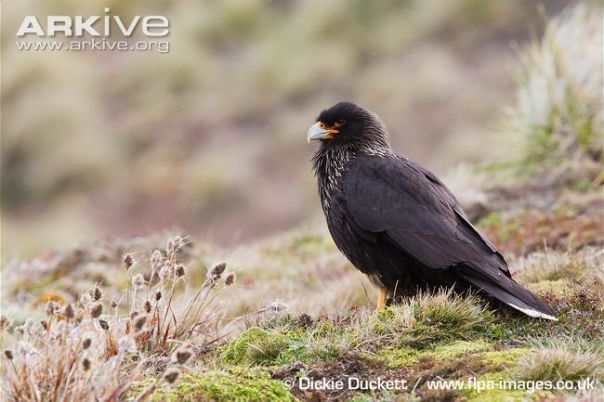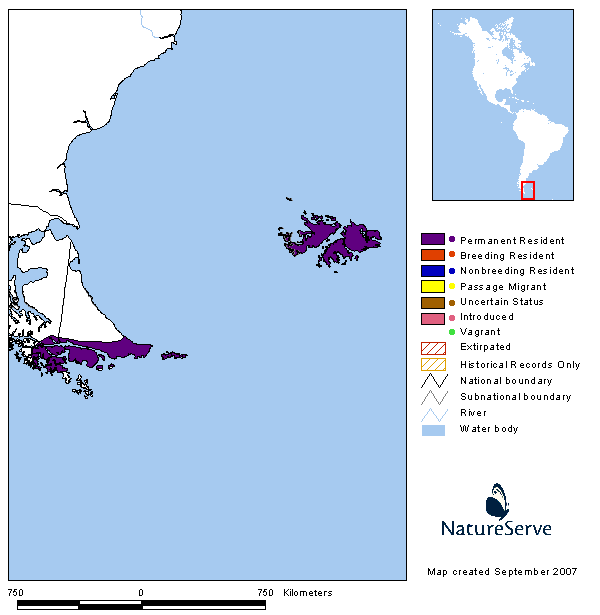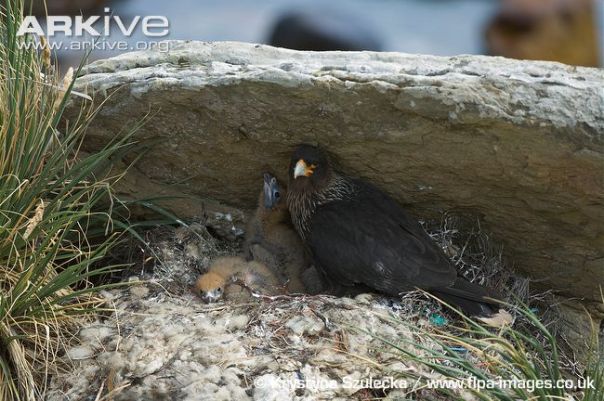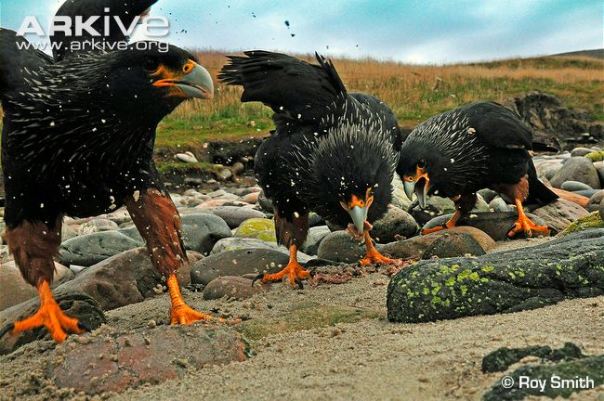- Name: Striated caracara
- Latin: Phalcoboenus australis
- Classification: Bird
- Origin: Falkland Islands
- Lifespan: 25 years
- AKA: Johnny rook, Falkland caracara
Taxonomy
- Kingdom: Animalia (Animals)
- Phylum: Chordata (Vertebrates)
- Class: Aves (Birds)
- Order: Falconiformes (Falcons and caracaras)
- Family: Falconidae (Falcons, kestrels and falconets)
- Genus: Phalcoboenus (Andes, Patagonia and Falkland Islands)
- Species: Phalcoboenus australis (Striated caracara)
Appearance
- Height: 53-65cm (20.8-25.5 inches)
- Weight:2-2.3kg (2.6-5lb)
- Wingspan: 116-125cm (45.6-49.2 inches)
The striated caracara is a dark bird with the plumage ranging from deep brown to almost black. It has its characteristic white streaking on the nape of the neck running down the breast and along the upper back. The underwings are reddish-brown with white tips on the primary feathers and a white band at the end of the tail. The caracara has a blueish bill with bare yellow skin around the eyes and the base of the beak. There is no major sexual dimorphism between species.
Juveniles of the species have browner plumage than the adults. The have a tawny patch on the upper back in place of the distinctive white streaking and tail band. Youngsters acquire their full adult plumage at approximately five years of age.


Relatives
Below are all other members of the genus Phalcoboenus
- Carunculated caracara (Phalcoboenus carunculatus) -LEAST CONCERN-
- Mountain caracara (Phalcoboenus megalopterus) -LEAST CONCERN-
- White-throated caracara (Phalcoboenus albpgularis) -LEAST CONCERN-
Habitat & Distribution
The striated caracara is rare throughout much of its range however, is common on some of the smaller islands in the West Falklands. They exist on isolated coasts and islands off extreme South Argentina and Chile. These birds are also found on islands where populations of seal and / or seabirds are present, including the south and east coasts of Isla Grande on Tierra del Fuego, Isla de los Estados, Navarino, Cape Horn and the Falkland Islands. They occupy open lowland areas, mainly across rocky coastlines but may also inhabit higher elevations on low coastal mountains.
 Diet
Diet
The striated caracara is an opportunistic bird and primarily a scavenger. The majority of its diet is made up of carrion, offal and food scraps and will occasionally take insects and earthworms dug from the ground with its talons. They will also prey upon weak and injured animals including young seabirds and newborn lambs. The striated caracara has also been observed to dig seabirds nesting in their burrows during the day and then hunt for them on wing throughout the night. They will also eat the eggs and chicks of larger seabirds such as albatrosses and feed on the carcasses of dead fur seals and penguins.
These birds have also been observed moving rocks and raiding dustbins in order to access food sources and will scavenge the internal organs of butchered animals. Their tendency to attack newborn lambs and injured sheep have led to the development of a resentful relationship with local livestock owners.
 Behaviour
Behaviour
The striated caracara shows a level of tameness and curiosity unlike that of other raptors. They show little fear of humans and will often examine tourists by tugging at shoelaces and trouser legs or stealing hats and cameras. Their curious behaviour is more like that of a corvid and it is thought that this ‘pathological curiosity’ helps the birds to develop novel ways of finding food. They fearlessly examine everything in their environment and are able to take advantage of a wide diversity of food sources.
Striated caracaras are highly social and juveniles with exhibit ‘gang’ behaviour similar to that of corvids in order to compete with the more aggressive adults. Adults are also territorial and will advertise their presence with loud calls. They are a non-migratory species but will move seasonally up into coastal mountains.

Reproduction
The breeding season of the striated caracara occurs in austral summer, from December to late February. The male and female will display to each other, such as the ‘head throwing’ display. The nest is built either on the ground or on cliff ledges and is constructed of twigs and vegetation and lined with grass and wool. These birds are loosely colonial, with neighboring pairs often nesting less than 10 meters from each other when nest sites are scarce.
The female will lay a clutch of approximately four eggs, which are incubated for around 32 days. The hatching of the chicks is timed to coincide with the hatching of young seabirds, in order to secure a constant food supply for the caracaras offspring. The nest is defended by both adults, who will chase intruders away. The chicks fledge after approximately three months, who then form large juvenile groups.
 Adaptations
Adaptations
- The striated caracara shows a level of curiosity unlike that of other raptors. It is thought this behaviour is to help them take advantage of a wide range of food sources and find novel ways of reaching others.
- These birds have a set of sharp talons, common to all birds of prey. These claws aid the striated caracara in reaching food sources such as muscles, eggs, carcasses and earthworms.
- Like other raptors, the striated caracara has exceptional eyesight, which is eight times better than that of a human. This aids them in spotting potential items of food in the distance.
- After fledging, the juveniles form large groups. This increases their chances of surviving their first few winters, the times when juvenile mortality is high, and offers them better defense against aggressive adults.
Threats
Due to their curiosity and lack of fear towards humans, the striated caracara became a pest to sheep farmers by targeting newborn lambs and weak ewes. In 1908, they became designated officially as a pest species and a bounty was put on their heads on the Falkland Islands. Farmers were paid for every beak they handed in, and in just 17 years, the striated caracara was eliminated from East and West Falkland. In the 1920’s however, Government Naturalist, James E. Hamilton, objected to the killing of the birds and bounties were stopped in 1930. They did not receive protection however, until 1964.
The current population size is limited to approximately 1,000-2,499 mature individuals, which equates to 1,500-3,749 individuals altogether. A survey conducted in 2006 also found that the population was stable at around 500 pairs. At present, the striated caracara is not considered to be facing any serious threats.
Conservation
- IUCN Status: Near Threatened
The striated caracara is officially protected by Falklands Islands (Malvinas) Law which makes it illegal to kill this bird without written permission from the government. They are also listed under CITES Appendix II, which classifies the striated caracara as ‘not necessarily threatened with extinction, but trade must be controlled in order to avoid utilization incompatible with their survival’.
Research and data collecting is also due to or already being carried out on the striated caracara including monitoring of the breeding population (which includes ringing to monitor juvenile mortality rate), ecology, dispersal, population dynamics and survival and to assess the damage to livestock caused by striated caracaras and evaluate the impact on sheep farming.
Since 1972, New Islands in West Falkland has been protected and managed as a private nature reserve which has allowed the striated caracara to re-colonize the island and now represents the largest single-island breeding population throughout their range.
Fun Facts
- Male: Tercle, tierce
- Female: Tiercelet
- Young: Chick, eyass
- Group: Cast, flock
- Also known as ‘flying devil’, Johnny rook’ and ‘winged pirate’.
- They are considered to be one of the most intelligent birds of prey.
- They have been observed hunting in groups of up to 50 individuals.
- They have been known to steal mainly red objects. It is thought because the birds mistake them for meat.
References
Arkive (2015) Striated Caracara (Phalcoboenus australis) [Online] Available at: http://www.arkive.org/striated-caracara/phalcoboenus-australis/image-G36841.html [Accessed: 30 October 2015]
Beauty of Birds (2015) Striated Caracara (Phalcoboenus australis) [Online] Available at: http://beautyofbirds.com/striatedcaracaras.html [Accessed: 31 October 2015]
Bird Land (2014) 20th June 2014 Species Spotlight – Striated Caracara [Online] Available at: http://www.birdland.co.uk/20th-june-2014-species-spotlight-striated-caracara/ [Accessed: 6 November 2015]
Bird Life (2015) Striated Caracara Phalcoboenus australis [Online] Available at: http://www.birdlife.org/datazone/speciesfactsheet.php?id=3568 [Accessed: 31 October 2015]
IUCN Red List (2015) Phalcoboenus australis [Online] Available at: http://www.iucnredlist.org/details/22696247/0 [Accessed: 6 November 2015]
Boise State University (2015) Autilio, Anna – Striate Caracara (Phalcoboenus australis) [Online] Available at: http://raptorresearchcenter.boisestate.edu/autilio-anna/ [Accessed: 6 November 2015]
Oiseaux Birds (2015) Striated Caracara – Phalcoboenus australis [Online] Available at: http://www.oiseaux-birds.com/card-striated-caracara.html [Accessed: 6 November 2015]
Wikipedia (2015) Striated Caracara [Online] Available at: https://en.wikipedia.org/wiki/Striated_caracara [Accessed: 30 October 2015]
